Hills, Mills, Bridges, and Chimneys: A Glimpse into Pittsburgh’s Past
- Like
- Digg
- Tumblr
- VKontakte
- Buffer
- Love This
- Odnoklassniki
- Meneame
- Blogger
- Amazon
- Yahoo Mail
- Gmail
- AOL
- Newsvine
- HackerNews
- Evernote
- MySpace
- Mail.ru
- Viadeo
- Line
- Comments
- SMS
- Viber
- Telegram
- Subscribe
- Skype
- Facebook Messenger
- Kakao
- LiveJournal
- Yammer
- Edgar
- Fintel
- Mix
- Instapaper
- Copy Link
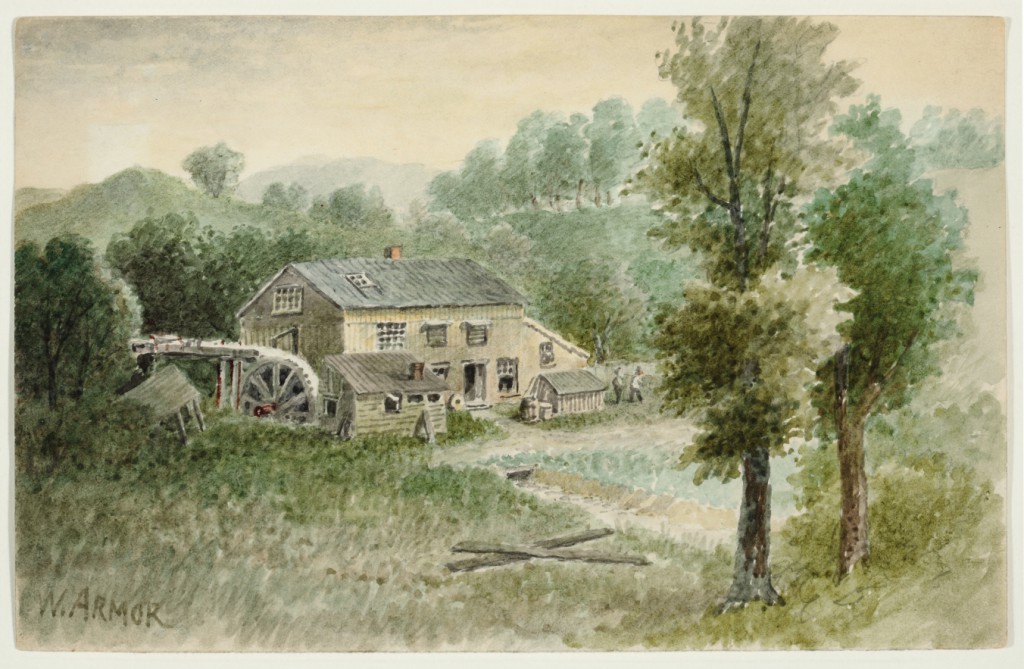
“The Mill at Millvale on the PRR at Pittsburgh” 1860 by William Gillespie Armor (American, 1834–1924). Watercolor, 5 1/4 x 8 in. from the collection of Sheryl and Bruce Wolf.
The Frick Art Museum’s exhibition of Pittsburgh landscapes is like viewing the city through a lens into the past: each work is so familiar, and yet entirely foreign; places and landmarks easily recognizable, and yet as though they’re from another world.
Hills and Mills: Pittsburgh on Paper at The Frick is an exhibition of late 19th Century to early 20th Century Pittsburgh landscapes, including sketches, watercolors, and prints, from the collection of Sheryl and Bruce Wolf.
The earliest work, “Pittsburg,” is by an unknown artist and dated to 1840. The chalk work depicts the south shore of the Ohio River from north of the point, looking towards neat, stylized sketches of buildings and smokestacks, and boats on the river.
“The Mill at Millvale on the PRR at Pittsburgh” (1860), by William Gillespie Armor, whose work features heavily in the show, depicts a view far removed from the neighborhood today — a charming rural scene, with the rustic mill nestled amongst tree-dotted hills. Sixteen years later Armor created a detailed pen and ink drawing of Andrew Carnegie’s Edgar Thomson Steel Works. The plant is still in operation today.
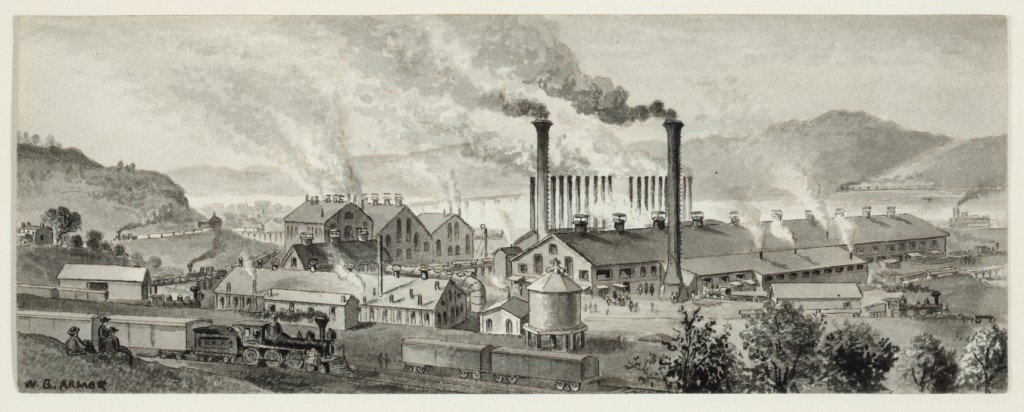
William Gillespie Armor, “View at Braddock’s Field at the Edgar Thomson Steel Works” (c. 1876). Pen and ink with grey wash, 3 3/8 x 9 in. Collection of Sheryl and Bruce Wolf.
From there, the works chronicle the city’s rapid industrialization during the first four decades of the 1900s, with rural scenes giving way to a smokestacks and factories. In Otto Kuhler’s “Valley of Work”, a 1925 etching and drypoint, chimneys dominate the cityscape and smoke fills the sky, blurring out details of the city.
Looking at these images of Pittsburgh past, it’s easy to be glad this version of the city is all but gone, along with the grey smoke and belching chimneys. But viewed through the lens of artists of the time, many of the works give a sense of a burgeoning, prosperous city being celebrated rather than lamented.
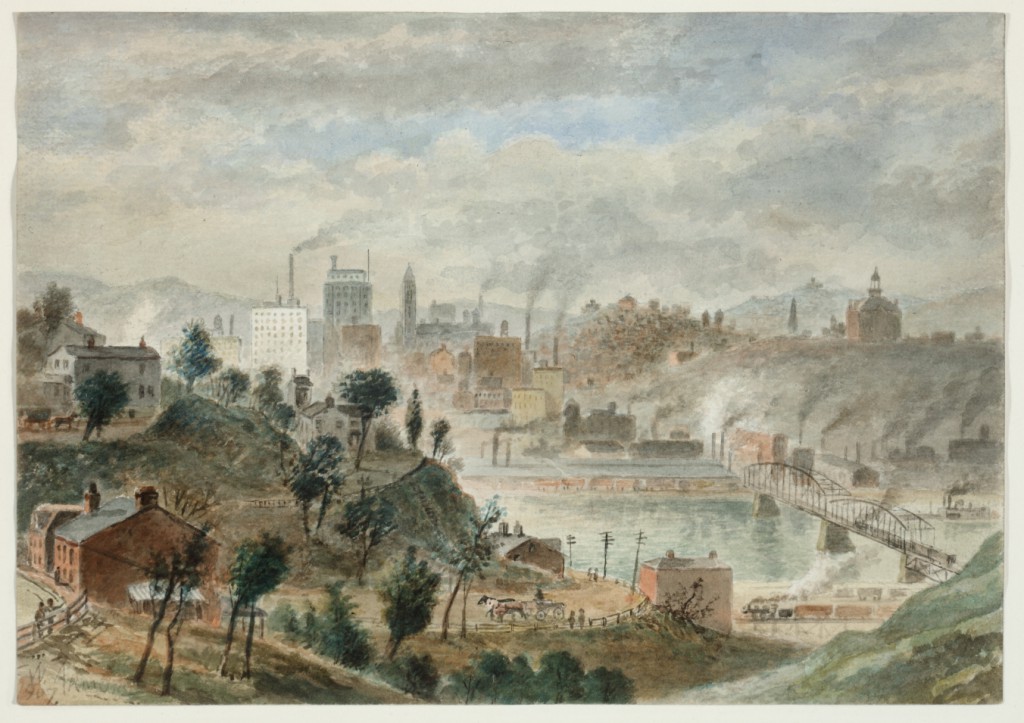
Pittsburgh’s prosperous skyline in William Gillespie Armor’s (American, 1834 – 1924) “Pittsburgh from Mount Washington” (1907). Watercolor, 6 1/4 x 8 3/4 in. Collection of Sheryl and Bruce Wolf.
In Armor’s version of Pittsburgh, green hills, the picturesque river and bridges are pulled to the foreground, while the smoking factories and mills are an almost romanticized background — a reminder of the city’s vitality and progress.
Pittsburgh’s bridges are also a frequent focal point, and make it easy to place the cityscapes within the modern city. In Ernest Boyer’s “Bridges (Westinghouse Bridge)”, 1933, the clean modern arches of the bridge are depicted in smooth grey tones. The 7th Street Bridge features in Japanese artist Yoshida Hiroshi’s “Night Rain At Pittsburgh” (1928), in which downtown is shown as roughly sketched skyscrapers dotted with pinpoints of light.
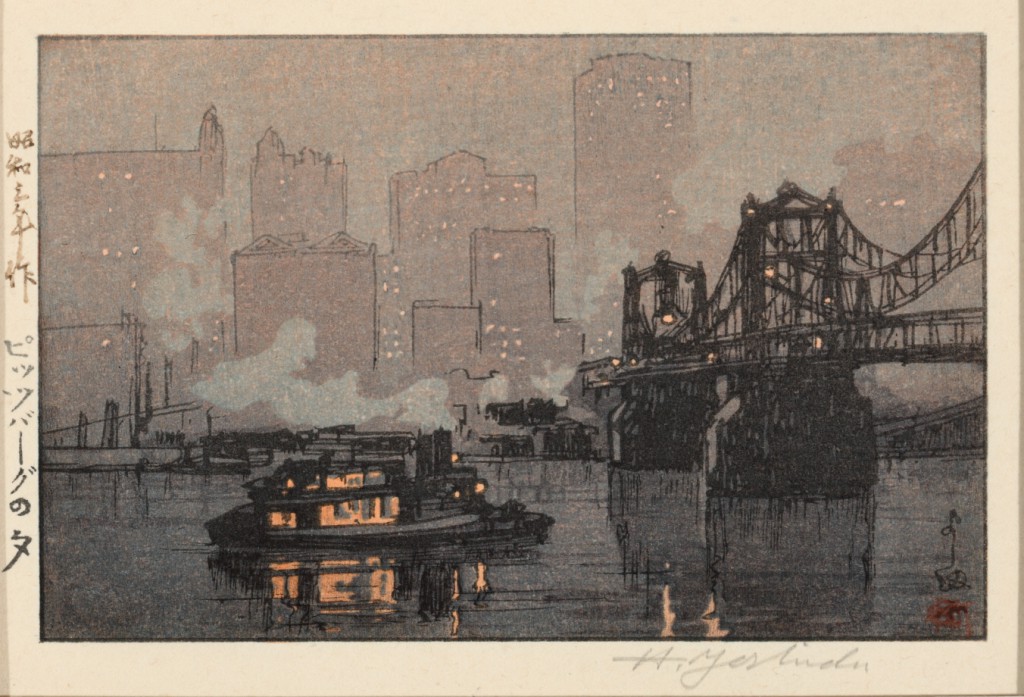
“Night Rain at Pittsburgh” (1928), a color woodcut, 3 1/4 x 5 in. by Yoshida Hiroshi (Japanese, 1876–1950). Collection of Sheryl and Bruce Wolf.
One of the most recent pieces, Louise Boyer’s “The Haves and the Have-Nots (Pittsburgh Series No. 2)” 1933, depicts the social realities for many of the workers in this industrial powerhouse, with rickety hillside houses in the foreground contrasted with the sculptural lines of downtown skyscrapers. The piece is a drypoint etching on an aluminum plate. Boyer worked with aluminum company Alcoa in developing aluminum etching plates, in an example of artist and industry working together.
It’s easy to spend a good amount of time pouring over the details in Hills and Mills: Pittsburgh on Paper – but it’s not the main event in the Frick’s exhibition hall this summer. It’s a complementary exhibition to a travelling show by Amgueddfa Cymru-National Museum Wales and the American Federation of Arts.
Rolling Hills, Satanic Mills: The British Passion for Landscape depicts British landscape painting from the 1600s through to contemporary works, with more than 60 pieces on display.
The works are grouped thematically, moving from classical 17th Century landscape painting, to Turner and the Sublime, featuring six works by J.M.W. Turner, noted British landscape artist, and Truth to Nature, featuring early photography and small, detailed depictions of the natural world.
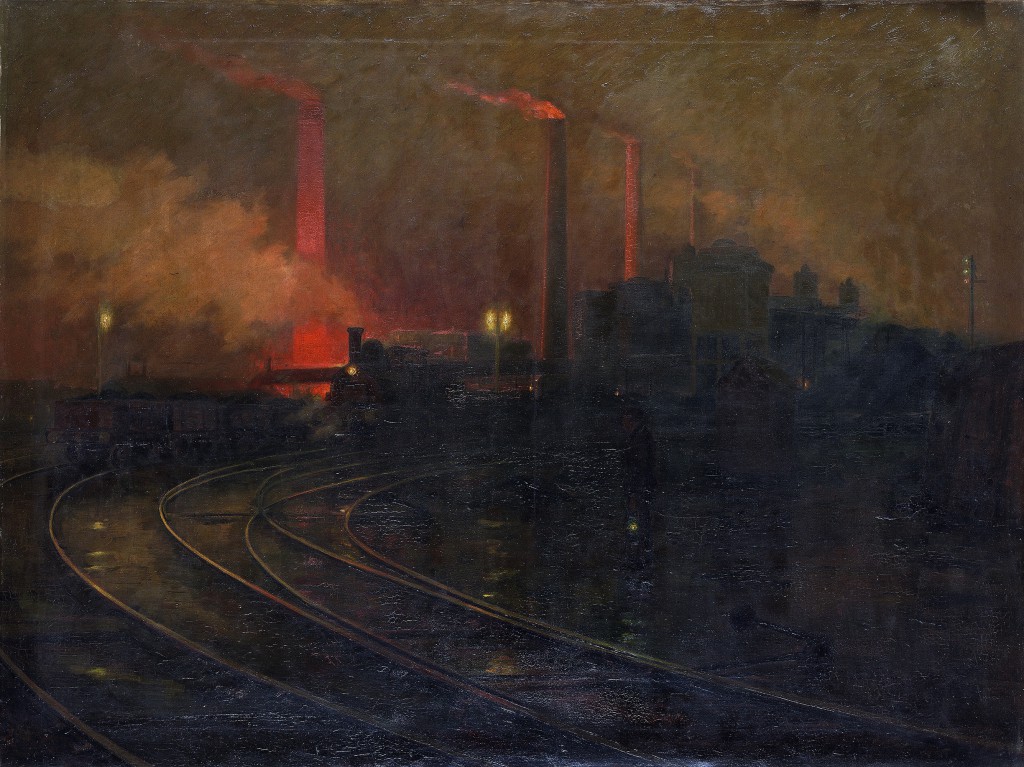
Lionel Walden’s “Steelworks, Cardiff, at Night” (1895-97). Oil on canvas, 59 3/8 x 78 x 7/8 in. National Museum Wales (NMW A 2245). Courtesy American Federation of Arts.
The reference to “satanic mills” in the title of the show is borrowed from a poem by William Blake, and in the Picturing Modernity section, the works give some idea of his inspiration. In Lionel Walden’s “Steelworks, Cardiff, At Night” (1895-97), steel furnaces taint the sky red in an otherwise dark and grim scene.
In the Monet and Impressions of Britain section, two works by Claude Monet during his time of exile in Britain are featured, including the muted, hazy “Charing Cross Bridge” (1902), as viewed from his balcony at the Savoy Hotel.
A modernist approach to the traditional subject matter is depicted in the Neo Romatic to Post Modern section, the final theme.
The exhibition concludes with a pop-up store featuring books and postcards related to the show, as well as treats for Anglophiles inspired by the British scenes — books on British cooking, gardens, and English tea and biscuits.
The two exhibitions are a natural fit, and the Frick Art Museum, on the grounds of the former home of industrialist Henry Clay Frick, seems a very apt location for them. To place them even more firmly in a local context, the Frick is offering a companion tour of Frick’s PIttsburgh home, Clayton, looking at his career and art collection.
Gallery talks are also being held on Fridays until the exhibition closes, with curators and educators talking about the artists and themes in the exhibition.
Rolling Hills, Satanic Mills: The British Passion for Landscape
Hills and Mills: Pittsburgh on Paper
Until August 2, The Frick Art & Historical Center, 7227 Reynolds St, Point Breeze
Heather McCracken is a Pittsburgh-based freelance journalist.
Share on Social Media
- Like
- Digg
- Tumblr
- VKontakte
- Buffer
- Love This
- Odnoklassniki
- Meneame
- Blogger
- Amazon
- Yahoo Mail
- Gmail
- AOL
- Newsvine
- HackerNews
- Evernote
- MySpace
- Mail.ru
- Viadeo
- Line
- Comments
- SMS
- Viber
- Telegram
- Subscribe
- Skype
- Facebook Messenger
- Kakao
- LiveJournal
- Yammer
- Edgar
- Fintel
- Mix
- Instapaper
- Copy Link
Follow Entertainment Central
Sign up for the EC Newsletter
Latest Stories







